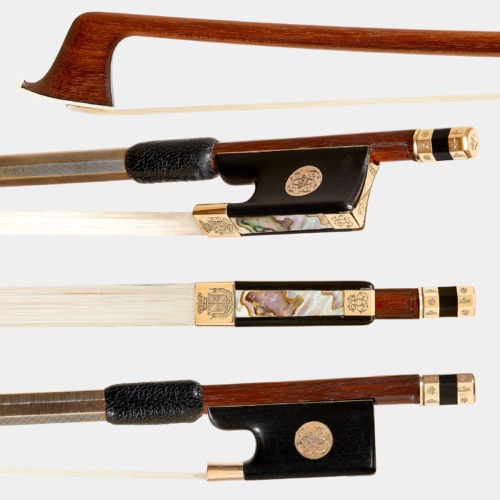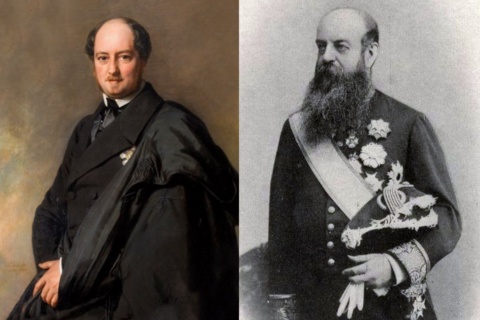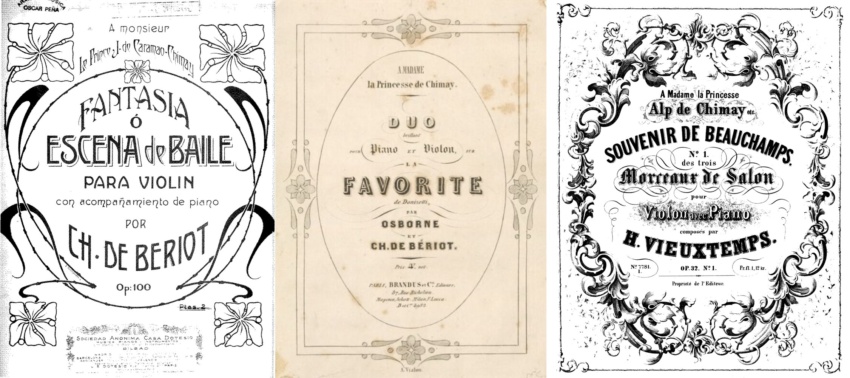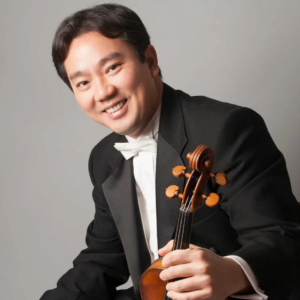Instruments by Jean-Baptiste Vuillaume were all the rage in the mid-19th century. His production was vast and his clientele extended from London to St. Petersburg. If you were a soloist, you knew Vuillaume; if you were a collector of fine instruments, you knew Vuillaume; if you couldn’t afford a Stradivari – and even if you could – you wanted a violin made by Vuillaume. The most successful French maker of all time, Vuillaume created a dynasty and developed a contemporary following like no other maker has done since.
If you were a soloist, you knew Vuillaume; if you were a collector of fine instruments, you knew Vuillaume; if you couldn’t afford a Stradivari – and even if you could – you wanted a violin made by Vuillaume.

The Prince Caraman de Chimay bow by Pierre Simon, J. B. Vuillaume’s best bow maker at the time. (click to enlarge)
In the 1860s, at the height of his success, Vuillaume made three matched quartets of instruments: the ‘Évangélistes’, the ‘Caraman de Chimay’ and the ‘Sheremetev’. The ‘Évangélistes’ had the names of Saints Mathieu, Marc, Luc and Jean inscribed at the center of the table between the soundholes; the latter two quartets were made at the behest of two of Vuillaume’s best clients, the Chimay and Sheremetev families, and emblazoned with their coat of arms. But while the quartets have attracted much attention, what’s less well-known is that Vuillaume also asked his best bow maker at the time, Pierre Simon, to make a quartet of decorated bows to go with the instruments. Although the ‘Chimay’ and ‘Sheremetev’ quartets were split up in the 20th century, the individual instruments and bows are still being played and enjoyed to this day. Earlier this year, Tarisio sold one of the violin bows of the ‘Chimay’ quartet by Private Sale.
The ‘Caraman-Chimay’ Pierre Simon is mounted in ebony and gold. The Vuillaume-style frog has rounded edges and sits on a convex track in the handle of the stick. The metal elements are engraved with the arms and iconography of the Caraman de Chimay family. On the ferrule is the crest with the Latin motto “Juvat Pietas”, literally meaning, ‘piety helps’. The facets of the button are engraved with a half lily and a rose, elements found in the Caraman-Chimay arms. A bird with crossed, closed wings is engraved on the heel plate above the date 1864. The small heel bears two entwined Cs and the same motif surrounding a crown is engraved on the oversized gold discs inset on each side of the frog.
The Princes Caraman de Chimay

The 17th and 18th Princes de Caraman-Chimay (left to right), (Prince Joseph de Riquet de Caraman Chimay père and fils).
The Prince of Chimay is a title of Belgian nobility connected with the town of Chimay at the western edge of Belgium, bordering France. Since the Middle Ages, the hereditary titles of Count and Prince of Chimay have passed through male heirs of the Croÿ, Arenberg, Hénin-Liétard and Riquet de Caraman families. The current prince, Philippe de Caraman-Chimay, is the 22nd Prince de Chimay. The two men responsible for the ‘Chimay’ quartet commissioned from Vuillaume were 17th and 18th in the Chimay succession, Joseph Philippe and his son, Marie Joseph Guy Henry Philippe. Confusingly, both men went by Joseph – even the violin dealers Gand Frères often confused them – so we’ll call them père and fils, father and son, to keep them straight.

Charles de Bériot dedicated his Scène de Ballet for violin and orchestra opus 100 to Prince Caraman de Chimay in c. 1845 and his Duo Brillant opus 73 to Princess Chimay. Henri Vieuxtemps dedicated the three salon pieces of his opus 32 published in 1856, Souvenir de Beauchamps, Rondino and La Chasse to Madame Princess Alp de Chimay.
Joseph père (1808-1886), a businessman and diplomat, was influential in establishing the independent Belgium we know today. When William I, the Prince d’Orange, abdicated as King of the Netherlands, Chimay led the negotiations that resulted in the Treaty of London in 1839, which guaranteed the independence of Belgium from the Netherlands. He also forged important diplomatic relationships for Belgium with various European neighbors and courts – the Vatican, the German confederation and the Courts of Tuscany and Naples, among others. Joseph fils (1836-1892) served as Belgian Ambassador to the Holy See from 1846-47 and as Foreign Minister of Belgium from 1884 until his death in 1892.
The two princes, and indeed the entire Caraman de Chimay family, shared an intense and compulsive love of music.
The two princes, and indeed the entire Caraman de Chimay family, shared an intense and compulsive love of music. In 1808, the year Joseph père was born, Luigi Cherubini wrote his F major mass, which he named Messe de Chimay, while staying at the Chimay château. Later that year he gave the premier of the mass in the château’s theater. Charles de Bériot, the great Belgian violinist, dedicated his Scène de Ballet for violin and orchestra opus 100 to Joseph père and his Duo Brillant opus 73 to Princess Chimay. De Bériot met his wife, the acclaimed Spanish singer María Malibran, at the Chimay château in 1829. De Bériot’s pupil and fellow Belgian virtuoso, Henri Vieuxtemps, dedicated his opus 32, the 3 Morceaux de Salon, to Madame Princess Alp de Chimay.
Joseph fils studied with de Bériot and eventually bought his teacher’s violin, then known as a Maggini. His wife, Marie Joséphine Anatole de Montesquiou-Fezensac, was an accomplished pianist; his second son, Pierre, was a cellist who studied with the son of Adrien-François Servais and later bought the ‘Servais’ Stradivari; and his eldest daughter, Élisabeth, was a saloniste and taste-maker who influenced the careers of Gabriel Faure, Sergei Diaghilev, Auguste Rodin, James McNeill Whistler, Marie Curie and many others. In 1881 she married the Vicomte Henry Greffulhe and four years later, Greffulhe bought the eponymous decorated Stradivari of 1709.

